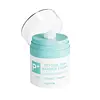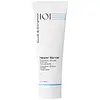What's inside
What's inside
 Key Ingredients
Key Ingredients

 Benefits
Benefits

 Concerns
Concerns

 Ingredients Side-by-side
Ingredients Side-by-side

Water
Skin ConditioningGlycerin
HumectantDipropylene Glycol
HumectantCaprylic/Capric Triglyceride
MaskingButylene Glycol
HumectantCetyl Alcohol
EmollientCetearyl Olivate
Niacinamide
SmoothingCetyl Ethylhexanoate
EmollientButyrospermum Parkii Butter
Skin Conditioning1,2-Hexanediol
Skin ConditioningSorbitan Olivate
EmulsifyingGlyceryl Stearate
EmollientIsononyl Isononanoate
EmollientStearyl Alcohol
EmollientPalmitic Acid
EmollientVinyldimethicone
Polyglyceryl-6 Stearate
EmollientCarbomer
Emulsion StabilisingTromethamine
BufferingMyristyl Alcohol
EmollientDiisostearyl Malate
EmollientHydroxyethyl Acrylate/Sodium Acryloyldimethyl Taurate Copolymer
Emulsion StabilisingBetaine
HumectantXanthan Gum
EmulsifyingPanthenol
Skin ConditioningSqualane
EmollientArgania Spinosa Kernel Oil
EmollientLauryl Alcohol
EmollientEthylhexylglycerin
Skin ConditioningTocopheryl Acetate
AntioxidantPolyglyceryl-6 Behenate
Emulsion StabilisingAdenosine
Skin ConditioningDisodium EDTA
Sorbitan Isostearate
EmulsifyingStearic Acid
CleansingMyristic Acid
CleansingSodium Hyaluronate
HumectantCeramide NP
Skin ConditioningCaprylyl Glycol
EmollientAcetyl Hexapeptide-8
HumectantWater, Glycerin, Dipropylene Glycol, Caprylic/Capric Triglyceride, Butylene Glycol, Cetyl Alcohol, Cetearyl Olivate, Niacinamide, Cetyl Ethylhexanoate, Butyrospermum Parkii Butter, 1,2-Hexanediol, Sorbitan Olivate, Glyceryl Stearate, Isononyl Isononanoate, Stearyl Alcohol, Palmitic Acid, Vinyldimethicone, Polyglyceryl-6 Stearate, Carbomer, Tromethamine, Myristyl Alcohol, Diisostearyl Malate, Hydroxyethyl Acrylate/Sodium Acryloyldimethyl Taurate Copolymer, Betaine, Xanthan Gum, Panthenol, Squalane, Argania Spinosa Kernel Oil, Lauryl Alcohol, Ethylhexylglycerin, Tocopheryl Acetate, Polyglyceryl-6 Behenate, Adenosine, Disodium EDTA, Sorbitan Isostearate, Stearic Acid, Myristic Acid, Sodium Hyaluronate, Ceramide NP, Caprylyl Glycol, Acetyl Hexapeptide-8
Water
Skin ConditioningSqualane
EmollientGlycerin
HumectantDicaprylyl Carbonate
EmollientJojoba Oil/Macadamia Seed Oil Esters
Skin ConditioningPolyglyceryl-3 Methylglucose Distearate
EmulsifyingButylene Glycol
HumectantCetearyl Alcohol
EmollientHydroxyethyl Acrylate/Sodium Acryloyldimethyl Taurate Copolymer
Emulsion StabilisingSimmondsia Chinensis Seed Oil
EmollientSaccharide Isomerate
HumectantCamellia Sinensis Leaf Extract
AntimicrobialBisabolol
MaskingAllantoin
Skin ConditioningCeramide Ng
Skin ConditioningSqualene
EmollientPhytosteryl Macadamiate
Skin ConditioningPhytosterols
Skin ConditioningTocopherol
AntioxidantTocopheryl Acetate
AntioxidantCitric Acid
BufferingSodium Citrate
BufferingEthylhexylglycerin
Skin ConditioningPhenoxyethanol
PreservativeWater, Squalane, Glycerin, Dicaprylyl Carbonate, Jojoba Oil/Macadamia Seed Oil Esters, Polyglyceryl-3 Methylglucose Distearate, Butylene Glycol, Cetearyl Alcohol, Hydroxyethyl Acrylate/Sodium Acryloyldimethyl Taurate Copolymer, Simmondsia Chinensis Seed Oil, Saccharide Isomerate, Camellia Sinensis Leaf Extract, Bisabolol, Allantoin, Ceramide Ng, Squalene, Phytosteryl Macadamiate, Phytosterols, Tocopherol, Tocopheryl Acetate, Citric Acid, Sodium Citrate, Ethylhexylglycerin, Phenoxyethanol
 Reviews
Reviews

Ingredients Explained
These ingredients are found in both products.
Ingredients higher up in an ingredient list are typically present in a larger amount.
Butylene Glycol (or BG) is used within cosmetic products for a few different reasons:
Overall, Butylene Glycol is a safe and well-rounded ingredient that works well with other ingredients.
Though this ingredient works well with most skin types, some people with sensitive skin may experience a reaction such as allergic rashes, closed comedones, or itchiness.
Learn more about Butylene GlycolEthylhexylglycerin (we can't pronounce this either) is commonly used as a preservative and skin softener. It is derived from glyceryl.
You might see Ethylhexylglycerin often paired with other preservatives such as phenoxyethanol. Ethylhexylglycerin has been found to increase the effectiveness of these other preservatives.
Glycerin is already naturally found in your skin. It helps moisturize and protect your skin.
A study from 2016 found glycerin to be more effective as a humectant than AHAs and hyaluronic acid.
As a humectant, it helps the skin stay hydrated by pulling moisture to your skin. The low molecular weight of glycerin allows it to pull moisture into the deeper layers of your skin.
Hydrated skin improves your skin barrier; Your skin barrier helps protect against irritants and bacteria.
Glycerin has also been found to have antimicrobial and antiviral properties. Due to these properties, glycerin is often used in wound and burn treatments.
In cosmetics, glycerin is usually derived from plants such as soybean or palm. However, it can also be sourced from animals, such as tallow or animal fat.
This ingredient is organic, colorless, odorless, and non-toxic.
Glycerin is the name for this ingredient in American English. British English uses Glycerol/Glycerine.
Learn more about GlycerinThis is a synthetic polymer. It helps improve the texture of products by adding thickness and gel-like feel.
It is also an emulsifer, meaning it prevents ingredients such as oil and water from separating. It also helps evenly disperse other ingredients.
Squalane is an emollient that helps the skin hold onto moisture. It's an oily liquid that occurs naturally in certain types of fish and plant oils.
Because squalane boosts hydration in the skin, it also comes with plenty of benefits: it is an antioxidant and can help fight free radicals and skin damage. Squalane is also found to have a detoxifying effect when applied.
Squalane comes from squalene, which occurs naturally within the sebum of our skin. It is one of the oils our skin produces to keep itself hydrated. Squalane is the hydrogenated version of squalene and has a longer shelf life.
Research shows that squalane is non-irritating (even at 100% concentration).
In general, it's a fantastic ingredient. It does a great job at hydrating the skin, and it's suitable for those with sensitive skin.
The source of squalane may impact malassezia / fungal acne. This is because olive oil derived squalane can contain impurities such as fatty acids and plant waxes. Sugarcane derived squalane is recommended for anyone with malassezia concerns.
Is squalane vegan?
This depends on the source. Squalane can be derived from both plants and animals. Most squalane used in skincare comes from plants.
Please note: the source of squalane is only known if disclosed by the brand. We recommend reaching out to the brand if you have any questions about their squalane.
Read more about squalene with an "e".
Is squalane an oil?
Squalane is often called an oil, but it’s technically not; it’s a hydrocarbon, meaning it’s only made of carbon and hydrogen, unlike true oils which are triglycerides made of fatty acids and glycerol.
The term “oil-free” isn’t regulated, so companies can define it however they want. Some exclude all oils, while others just avoid mineral oil or comedogenic oils.
While some people avoid oils thinking they cause breakouts, the right kind of oil (or oil-like ingredient like squalane) can actually help balance and hydrate your skin. It’s worth testing out simple oils or squalane to see what works best for your skin.
Learn more about SqualaneTocopheryl Acetate is AKA Vitamin E. It is an antioxidant and protects your skin from free radicals. Free radicals damage the skin by breaking down collagen.
One study found using Tocopheryl Acetate with Vitamin C decreased the number of sunburned cells.
Tocopheryl Acetate is commonly found in both skincare and dietary supplements.
Learn more about Tocopheryl AcetateWater. It's the most common cosmetic ingredient of all. You'll usually see it at the top of ingredient lists, meaning that it makes up the largest part of the product.
So why is it so popular? Water most often acts as a solvent - this means that it helps dissolve other ingredients into the formulation.
You'll also recognize water as that liquid we all need to stay alive. If you see this, drink a glass of water. Stay hydrated!
Learn more about Water